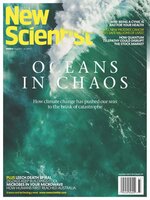New Scientist covers the latest developments in science and technology that will impact your world. New Scientist employs and commissions the best writers in their fields from all over the world. Our editorial team provide cutting-edge news, award-winning features and reports, written in concise and clear language that puts discoveries and advances in the context of everyday life today and in the future.
Elsewhere on New Scientist
A note from the culture editor
The cosmos in a teacup • Physical imitations of extreme astrophysical phenomena are genuinely useful
New Scientist
An eye-catching jewel of nature
Covid-19 vaccine tweak could better tackle today’s variants
Ethereum’s energy-saving update also closed security flaw
Fundamental physics law tested • A concept known as the principle of least action has finally been seen in the quantum realm
Bat guano has sculpted caves for thousands of years
Bowhead whales’ cancer secret • Their cells are very good at repairing DNA, which may explain the mammals’ lasting health
Volcano eruption disrupted satellites on far side of planet
CRISPR-edited cells could help with chronic heart failure
US desert grassland collapse is linked to Pacific changes
Octopuses may have nightmares about being attacked by predators
Software update could give wind farms a big boost
Meet the memcomputer • Proof-of-principle digital device shows it could trump standard machines
Rare plant turns carnivorous when low on phosphorus
Has Alzheimer’s met its match? • Antibodies that bind to a culprit protein have been hailed a “momentous breakthrough”, but do they live up to the hype, asks Clare Wilson
Genetic minefield
Kissing has been part of romantic encounters for at least 4500 years
Wolves are scaring smaller predators into human conflict
Stretchy e-skin responds to touch like the real thing
Stone Age markings are oldest known architectural plans
Comb jellies, not sponges, might be the oldest animal group
Running fast puts more strain on shins than going uphill
Racing drivers have synchronised blinks
Octopus-inspired ink can change colour
A house made from recycled diapers mixed into concrete
Really brief
Messaging the stars • If there are intelligent aliens out there, should we try to communicate with them? And who should speak for Earth, asks Chris Impey
Field notes from space-time • Best not to ask It feels like it should be easy to define space-time, but the concept is so outside the realm of everyday life it can seem beyond comprehension, says Chanda Prescod-Weinstein
Still life • Royal College of Surgeons of England
Your letters
Paradise exploded • An unusually profound and moving sci-fi thriller artfully transcends the familiar trope of a utopia concealing a dreadful secret, finds Neil McRobert
A world of irritation • An excellent guide unpicks the complexities of how our immune system causes allergic responses, says Elle Hunt
New Scientist recommends
The sci-fi column • Big shots Suppose the megarich can rejuvenate – but it makes them grow to titanic proportions? Nick Harkaway draws on Greek myth and noir in a fabulous thought experiment that reflects our own fixation with “making it big”, says Sally Adee
Tabletop universe • Physicists are conjuring crude models of the cosmos in glass tanks and tubes. Can these simulations reveal the secrets of space and time, asks Jon Cartwright
Where the waters run free • A visit to Europe’s only wild river national park highlights why such places are worth fighting for, reports Graham Lawton
Global free-flows
Meet your future self...

 Dec 14 2024
Dec 14 2024
 Dec 07 2024
Dec 07 2024
 Nov 30 2024
Nov 30 2024
 Nov 23 2024
Nov 23 2024
 Nov 16 2024
Nov 16 2024
 Nov 09 2024
Nov 09 2024
 Nov 02 2024
Nov 02 2024
 Oct 26 2024
Oct 26 2024
 Oct 19 2024
Oct 19 2024
 Oct 12 2024
Oct 12 2024
 Oct 05 2024
Oct 05 2024
 Sep 28 2024
Sep 28 2024
 Sep 21 2024
Sep 21 2024
 Sep 14 2024
Sep 14 2024
 Sep 07 2024
Sep 07 2024
 Aug 31 2024
Aug 31 2024
 Aug 24 2024
Aug 24 2024
 Aug 17 2024
Aug 17 2024
 Aug 10 2024
Aug 10 2024
 Aug 03 2024
Aug 03 2024
 Jul 27 2024
Jul 27 2024
 Jul 20 2024
Jul 20 2024
 Jul 13 2024
Jul 13 2024
 Jul 06 2024
Jul 06 2024
